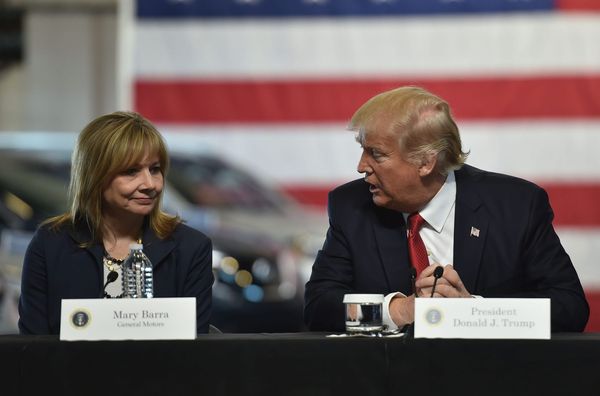
The first indication of trouble happened as soon as the first day, starting with the opening activity scheduled for Prince William and Kate Middleton, the Duke and Duchess of Cambridge, during a Caribbean royal tour to mark the occasion of Queen Elizabeth’s Platinum Jubilee.
Their visit to a cocoa farm in the foothills of the Maya Mountains of Belize on Sunday was canceled after villagers organized a protest against colonialism and the use of a soccer field for the landing of the royal helicopter.
Instead, William and Kate visited the family-run Che'il Mayan Cacao Farm and Chocolate Factory in Maya Center Village, a small village in the Stann Creek District of Belize, where they learned about chocolate-making.
Enthusiasm...and tension
Generally, the royal couple has been greeted with enthusiasm and deference wherever they’ve gone during their week-long Caribbean trip that has included Belize, Jamaica and the Bahamas.
But mounting tensions in the Caribbean nations where William's grandmother, Queen Elizabeth, is head of state have also been a feature of the trip, peppered with demonstrations and statements calling for an apology and reparations from the royal family for Britain’s long history of slavery and colonialism.
Royal experts in the British media are saying that “behind the smiles there is a storm brewing in the Caribbean.”
For the Mail Online “William and Kate's 'embarrassing' Caribbean tour saw them ambushed by Jamaican PM and meeting islanders behind fences.” It adds that “the couple had to expect dissent because 'times have changed.”
iNews headline is harder: “William and Kate’s Caribbean tour was an arrogant vanity project. No wonder it backfired.”
“Queen Elizabeth II is not only the monarch of the U.K., but also of 14 other countries, including Canada, Australia, and Papua New Guinea, known as the Commonwealth realms,” Time explains. “They are distinct from the Commonwealth of Nations, a group of 54 countries that were once part of the British Empire — the majority of which no longer recognize the Queen as sovereign.”
The role of the queen as head of state is mostly symbolic as the countries are ruled by elected governments. The queen is not involved in governing but she has some constitutional duties such as approving new governments and legislation.
Jamaica prepares to separate
In Kingston, Jamaica, the Cambridges were received by Prime Minister Andrew Holness and his wife, Juliet. Holness told them, referring to the government’s intention to remove the Queen as head of state, that "Jamaica is a country proud of its history and of what we have achieved. We are moving on and intend to fulfill our true ambitions and destiny to become an independent, developed and prosperous country.”
The Independent has reported that the Jamaican government has already begun the process of transitioning the island nation - the largest English speaking country in the Caribbean - to a republic.
The Jamaican warning has been compared with a similar royal visit last November by Prince Charles and his wife Camila, Duchess of Cornwall to Barbados, which not long after the royal tour broke ties with the queen, became a republic and elected its first president.
"It is important as we turn 60 years old as an independent nation that we stand as 'adults' on solid ethical, moral and human justice grounds," Norah Blake, the co-organizer of a protest in Jamaica, told The Independent. "To say to Britain, who was once our 'parent,' that you have done wrong in enriching yourselves off of chattel slavery and colonialism."
According to Time, “many observers say the trip was meant to persuade the three countries to keep the queen as head of state and not to follow Barbados, which transitioned to a republic last November. But growing calls to cut formal ties with the queen and campaigns for slavery reparations have ignited a reckoning with the region’s colonial past.”
With Queen Elizabeth, who is 95, having achieved 70 years in the throne and gradually relinquishing many of her duties, Prince William, 39, and Kate Middleton, 40, are seen as the modern face of both the family and the institution.
The prince has not ducked his country’s past, referring in various speeches on the tour to the practice of slavery as an 'appalling atrocity' and a 'stain in history that should never have happened', and expressing his 'profound sorrow' at the forced transportation of millions of people from Africa – a trade which British monarchs either supported or profited from during the 17th and 18th centuries.
But he has stopped short of the open apology protesters have been calling for.
A crucial test
This is Willliam’s and Kate's first official visit to the Caribbean. Prince Harry was the last senior royal to visit the Bahamas, Jamaica, and Belize in 2012 during a Diamond Jubilee Tour.
A statement by Kensington Palace explained that "as with previous overseas visits, The Duke and Duchess have asked that this tour allows them to meet as many local people as possible.
Over the course of their time in the Caribbean, Their Royal Highnesses will meet a wide variety of groups, including children, young people and families, frontline workers, service personnel, leaders from government, business and the charity sector as well as inspiring conservationists, and the early years workforce."
The royal couple, who left their three children, Prince George, Princess Charlotte and Prince Louis at home in London, have taken part in cultural, sports and traditional events organized in their honor and where they have wholeheartedly participated and been cheered by admiring fans.
Despite the protests and the complex political relations between the Caribbean nations and the British crown, William and Kate are immensely popular and the tour has been a crucial test of the monarchy’s relevance in the modern era.
The royal couple, and most particularly the Duchess of Cambridge, have dazzled in their impeccable elegance and effortless glamour.

The Duchess wore a shimmering turquoise bespoke silk gown with hand-tied bows at the shoulder from British designer Phillipa Lepley, that paid tribute to her host country's flag. Prince William appeared in a blue velvet tux.



For a regatta in Nassau, Kate wore a white polo shirt from Gill Marine, chino shorts, and Superga sneakers.

Under the Bahamas’ rain, Kate looked fresh in a mint green Self-Portrait pleated frock with white pumps.

On their last day in Jamaica, the Cambridges rode in the same open-top Land Rover that was used by Queen Elizabeth and Prince Philip during their visit to Jamaica in 1953. Kate wore a lacy white midi dress, a white hat and ivory Emmy London pumps for the occasion.

At Jamaica’s airport before their departure, Kate wore a hummingbird brooch that was a gift to Queen Elizabeth during her 2002 visit to Jamaica in celebration of her Golden Jubilee. The hummingbird is the national bird of Jamaica.

For their first day in the Bahamas Kate, once again, matched her dress to the country's flag.

For a reception dinner hosted by the Governor General of Jamaica, Kate wore an off-the-shoulder green gown by Jenny Packham.

For their meeting with Jamaica’s first minister, Kate wore an all-white Alexander McQueen suit with an orange blouse, pairing the look with white Jimmy Choo pumps and an orange Raffia bag.

Kate wore a vintage Yves Saint Laurent red jacket that she, reportedly, has owned since her university days.

For their arrival to Jamaica, Kate wore a canary yellow Roksanda dress in a tribute to the Jamaican flag.



For their visit to Trench Town, birthplace of reggae music, Kate wore a vintage 1950s dress from Willow Hilson.

At the Trench Town Culture Yard Museum, home of Bob Marley, the couple joined in live music, playing the drums.


For a special reception hosted by the Governor General of Belize in Cahal Pech, a Mayan archeological site outside San Ignacio, Belize, Kate chose a metallic gown with ruffled sleeves by The Vampire's Wife, a British brand, accessorized with an embroidered Mayan clutch.

They wore casual attire for the visit to ancient Mayan ruins at the Caracol archaeological site in the Chiquibul Forest in Belize.


For the beachside village of Hopkins, cultural center of the Afro-Indigenous Garifuna community in Belize, where Kate and William danced and took in the music, she wore a blue floral Tory Burch midi dress that matched the blue of Belize's flag.

Her bright blue earrings are the Charlie earrings from French brand Sézane.

For their arrival at Philip S. W Goldson International Airport in Belize to start their royal tour, Kate chose an all-blue Jenny Packham spring suit to pay tribute to the Caribbean country with a matching clutch.










